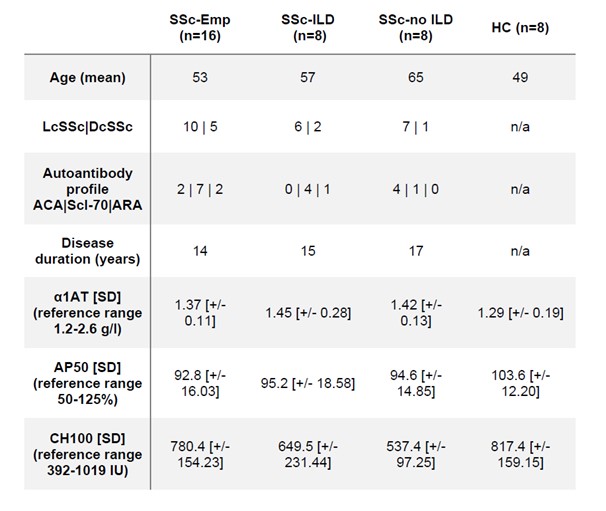Back
Poster Session B
Fibrosing rheumatic diseases (scleroderma, MCTD, IgG4-related disease, scleroderma mimics)
Session: (1046–1070) Systemic Sclerosis and Related Disorders – Clinical Poster I
1054: Distinct Differences in Complement Perturbation Between Scleroderma-related Interstitial Lung Disease with and Without Emphysema
Sunday, November 13, 2022
9:00 AM – 10:30 AM Eastern Time
Location: Virtual Poster Hall
- AC
Alice Cole, BSc, MBChB, MRCP
Royal Free Hospital
London, United Kingdom
Abstract Poster Presenter(s)
Claire Beesley1, Alice Cole2, Nina Goldman1, Odewale Oluwakorede1, Joseph Barnett2, David Abraham1, Chris Denton1, Rizgar Mageed3 and Voon Ong4, 1University College London, London, United Kingdom, 2Royal Free Hospital, London, United Kingdom, 3Experimental Medicine and Rheumatology, William Harvey Research Institute, Queen Mary University, London, United Kingdom, 4UCL Medical School Royal Free Campus, London, United Kingdom
Background/Purpose: Aberrant complement activation is associated with autoimmune diseases including systemic sclerosis (SSc). As a leading cause of death in SSc, interstitial lung disease (ILD) can coexist with emphysema in non-smoking patients, worsening prognosis. It has been suggested that the airway destruction observed in SSc patients may be an exaggerated inflammatory response related to increased complement activation.
Methods: We analysed 10 complement proteins in plasma samples of 16 non-smoking SSc patients with emphysema (SSc-Emp), 8 SSc no-ILD, 8 SSc-ILD patients and 8 healthy controls (HC) (Table.1) selected from 1800 SSc patients under active follow up. The extent and distribution of emphysema was evaluated on high resolution computed tomography (HRCT) and enzyme-linked immunosorbent assays (ELISA) were performed for measuring C1q, MASP-2, Factor B, Factor Bb, Factor H, C3, C3a, C4, C5, C5a and TCC (terminal complement complex). One-way ANOVA and post-hoc Tukey test were used for analysis.
Results: HRCT confirmed that amongst the emphysema cohort, there was a spectrum of mild to severe destruction including both paraseptal and centrilobular emphysema. All 16 SSc-Emp patients had ILD and 9 of the 16 patients demonstrated perivascular emphysema not previously described in SSc The SSc-ILD group was characterised by extensive lung fibrosis on CT, mean FVC 71% predicted. Across the four groups, C1q was significantly reduced in the SSc-ILD cohort (SSc-Emp 950±404 µg/mL, SSc-ILD 355±116 µg/mL, SSc-no ILD 1087±206 µg/mL, HC 858±210 µg/mL, p= 0.0002). In contrast, the ratio of C3a/C3 was significantly increased in the SSc-ILD group compared with the SSc-Emp group (SSc-ILD 0.12±0.07 vs SSc-Emp 0.06±0.03, p= 0.0283). The ratio of Bb/B was significantly increased in the SSc no-ILD group compared with all other groups (SSc-Emp 1.57±0.80, SSc-ILD 1.27±0.56, SSc-no ILD 3.86±1.12, HC 1.89±0.75, p< 0.0001). There was a trend towards an increased ratio of C5a/C5 in SSc-ILD and SSc-Emp compared with HC and reduced MASP2 in the SSc groups compared with HC.
Conclusion: These data demonstrate dysregulated complement levels in three SSc subgroups. Notably, the perturbed C1q and C3a:C3 pathways in SSc-ILD are reversed in SSc-emphysema, supporting complement activation as part of the divergent tissue remodelling responses in these distinct SSc lung phenotypes.
 Table 1. Demographics of each patient cohort including serological results for α1AT, and functional assay to rule out genetic complement pathway deficiency (AP50, CH100).
Table 1. Demographics of each patient cohort including serological results for α1AT, and functional assay to rule out genetic complement pathway deficiency (AP50, CH100).
Disclosures: C. Beesley, None; A. Cole, None; N. Goldman, None; O. Oluwakorede, None; J. Barnett, None; D. Abraham, None; C. Denton, Boehringer-Ingelheim, Roche, GlaxoSmithKlein(GSK), Horizon; R. Mageed, None; V. Ong, None.
Background/Purpose: Aberrant complement activation is associated with autoimmune diseases including systemic sclerosis (SSc). As a leading cause of death in SSc, interstitial lung disease (ILD) can coexist with emphysema in non-smoking patients, worsening prognosis. It has been suggested that the airway destruction observed in SSc patients may be an exaggerated inflammatory response related to increased complement activation.
Methods: We analysed 10 complement proteins in plasma samples of 16 non-smoking SSc patients with emphysema (SSc-Emp), 8 SSc no-ILD, 8 SSc-ILD patients and 8 healthy controls (HC) (Table.1) selected from 1800 SSc patients under active follow up. The extent and distribution of emphysema was evaluated on high resolution computed tomography (HRCT) and enzyme-linked immunosorbent assays (ELISA) were performed for measuring C1q, MASP-2, Factor B, Factor Bb, Factor H, C3, C3a, C4, C5, C5a and TCC (terminal complement complex). One-way ANOVA and post-hoc Tukey test were used for analysis.
Results: HRCT confirmed that amongst the emphysema cohort, there was a spectrum of mild to severe destruction including both paraseptal and centrilobular emphysema. All 16 SSc-Emp patients had ILD and 9 of the 16 patients demonstrated perivascular emphysema not previously described in SSc The SSc-ILD group was characterised by extensive lung fibrosis on CT, mean FVC 71% predicted. Across the four groups, C1q was significantly reduced in the SSc-ILD cohort (SSc-Emp 950±404 µg/mL, SSc-ILD 355±116 µg/mL, SSc-no ILD 1087±206 µg/mL, HC 858±210 µg/mL, p= 0.0002). In contrast, the ratio of C3a/C3 was significantly increased in the SSc-ILD group compared with the SSc-Emp group (SSc-ILD 0.12±0.07 vs SSc-Emp 0.06±0.03, p= 0.0283). The ratio of Bb/B was significantly increased in the SSc no-ILD group compared with all other groups (SSc-Emp 1.57±0.80, SSc-ILD 1.27±0.56, SSc-no ILD 3.86±1.12, HC 1.89±0.75, p< 0.0001). There was a trend towards an increased ratio of C5a/C5 in SSc-ILD and SSc-Emp compared with HC and reduced MASP2 in the SSc groups compared with HC.
Conclusion: These data demonstrate dysregulated complement levels in three SSc subgroups. Notably, the perturbed C1q and C3a:C3 pathways in SSc-ILD are reversed in SSc-emphysema, supporting complement activation as part of the divergent tissue remodelling responses in these distinct SSc lung phenotypes.
 Table 1. Demographics of each patient cohort including serological results for α1AT, and functional assay to rule out genetic complement pathway deficiency (AP50, CH100).
Table 1. Demographics of each patient cohort including serological results for α1AT, and functional assay to rule out genetic complement pathway deficiency (AP50, CH100).Disclosures: C. Beesley, None; A. Cole, None; N. Goldman, None; O. Oluwakorede, None; J. Barnett, None; D. Abraham, None; C. Denton, Boehringer-Ingelheim, Roche, GlaxoSmithKlein(GSK), Horizon; R. Mageed, None; V. Ong, None.

